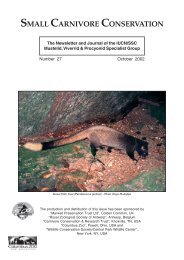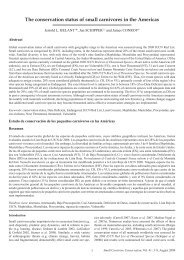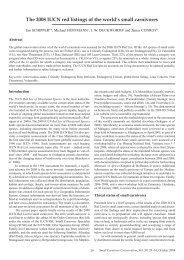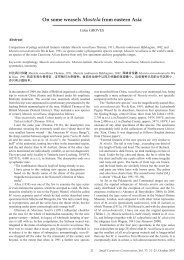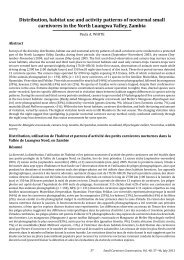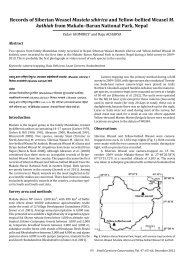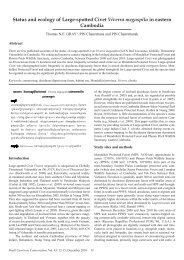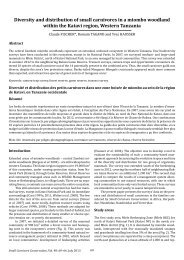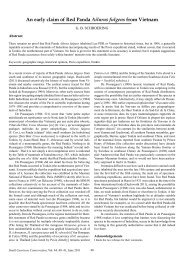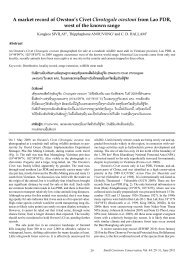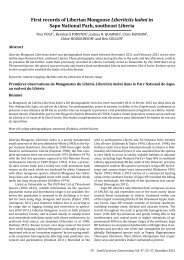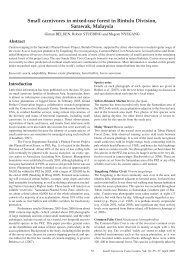First record of Hose's Civet Diplogale hosei from Indonesia, and ...
First record of Hose's Civet Diplogale hosei from Indonesia, and ...
First record of Hose's Civet Diplogale hosei from Indonesia, and ...
Create successful ePaper yourself
Turn your PDF publications into a flip-book with our unique Google optimized e-Paper software.
Abstract<br />
<strong>First</strong> <strong>record</strong> <strong>of</strong> Hose’s <strong>Civet</strong> <strong>Diplogale</strong> <strong>hosei</strong> <strong>from</strong> <strong>Indonesia</strong>,<br />
<strong>and</strong> <strong>record</strong>s <strong>of</strong> other carnivores in the Schwaner Mountains,<br />
Central Kalimantan, <strong>Indonesia</strong><br />
Hiromitsu SAMEJIMA 1 <strong>and</strong> Gono SEMIADI 2<br />
One <strong>of</strong> the least-<strong>record</strong>ed carnivores in Borneo, Hose’s <strong>Civet</strong> <strong>Diplogale</strong> <strong>hosei</strong>, was filmed twice in a logging concession, the<br />
Katingan–Seruyan Block <strong>of</strong> Sari Bumi Kusuma Corporation, in the Schwaner Mountains, upper Seruyan River catchment, Central<br />
Kalimantan. This, the first <strong>record</strong> <strong>of</strong> this species in <strong>Indonesia</strong>, is about 500 km southwest <strong>of</strong> its previously known distribution<br />
(northern Borneo: Sarawak, Sabah <strong>and</strong> Brunei). Filmed at 325 m a.s.l., these <strong>record</strong>s are below the previously known altitudinal<br />
range (450–1,800 m). This preliminary survey for medium <strong>and</strong> large mammals, running 100 camera-traps in 10 plots for one<br />
year, identified in this concession 17 carnivores, including, on The IUCN Red List <strong>of</strong> Threatened Species, three Endangered species<br />
(Flat-headed Cat Prionailurus planiceps, Bay Cat Pard<strong>of</strong>elis badia <strong>and</strong> Otter <strong>Civet</strong> Cynogale bennettii) <strong>and</strong> six Vulnerable species<br />
(B<strong>and</strong>ed <strong>Civet</strong> Hemigalus derbyanus, Binturong Arctictis binturong, Sunda Clouded Leopard Ne<strong>of</strong>elis diardi, Marbled Cat Pard<strong>of</strong>elis<br />
marmorata <strong>and</strong> Sun Bear Helarctos malayanus, as well as Hose’s <strong>Civet</strong>).<br />
Keywords: Borneo, camera-trapping, Cynogale bennettii, Pard<strong>of</strong>elis badia, Prionailurus planiceps, sustainable forest management<br />
Catatan Pertama mengenai Musang Gunung <strong>Diplogale</strong> <strong>hosei</strong> di <strong>Indonesia</strong>, serta karnivora lainnya<br />
di daerah Pegunungan Schwaner, Kalimantan Tengah<br />
Abstrak<br />
Salah satu jenis karnivora yang jarang dijumpai di Borneo, Musang Gunung, <strong>Diplogale</strong> <strong>hosei</strong>, telah terekam dua kali di daerah<br />
konsesi hutan Blok Katingan–Seruyan- PT. Sari Bumi Kusuma, Pegunungan Schwaner, di sekitar hulu Sungai Seruya, Kalimantan<br />
Tengah. Ini merupakan catatan pertama spesies tersebut terdapat di <strong>Indonesia</strong>, sekitar 500 km dari batas sebaran yang diketahui<br />
saat ini (Sarawak, Sabah, Brunei). Lokasi berada pada ketinggian 325 m di atas permukaan laut (d.p.l), jauh lebih rendah dari<br />
catatan yang saat ini diketahui (450–1800 m d.p.l). Survey mengenai mamalia sedang dan besar ini menggunakan 100 kamera<br />
di 10 lokasi selama satu tahun, mendapatkan 17 spesies karnivora, termasuk tiga spesies katagori terancam (kucing hutan Prionailurus<br />
planiceps, kucing merah Pard<strong>of</strong>elis badia, musang air Cynogale bennettii) dan enam jenis katagori rentan pada daftar<br />
IUCN (musang belang Hemigalus derbyanus, binturong Arctictis binturong, macan dahan Ne<strong>of</strong>elis diardi, kucing batu Pard<strong>of</strong>elis<br />
marmorata, beruang madu Helarctos malayanus, selain musang gunung).<br />
Kata kunci: Cynogale bennettii, kamera perangkap, Pard<strong>of</strong>elis badia, pengelolaan hutan berkelanjutan, Prionailurus planiceps,<br />
Pulau Kalimantan<br />
Introduction<br />
Tropical rainforest in Southeast Asia, particularly on the isl<strong>and</strong><br />
<strong>of</strong> Borneo, is known for its high species richness <strong>of</strong> carnivores<br />
(Primack & Corlett 2005). These include three endemic to Borneo:<br />
Bay Cat Pard<strong>of</strong>elis badia, Hose’s <strong>Civet</strong> <strong>Diplogale</strong> <strong>hosei</strong> <strong>and</strong><br />
Bornean Ferret Badger Melogale everetti, <strong>and</strong> one questionable<br />
species, Hose’s Mongoose Herpestes <strong>hosei</strong> (Payne et al. 1985,<br />
Corbet & Hill 1992). There are many recent distribution <strong>record</strong>s<br />
<strong>of</strong> carnivores in Sabah (e.g. Davies & Payne 1982, Heydon<br />
& Bulloh 1996, Wilting et al. 2010b, Brodie & Giordano 2011,<br />
Matsubayashi et al. 2011), <strong>and</strong> some <strong>from</strong> Brunei (e.g., Yasuma<br />
& Abdullah 1997a, 1997b), Sarawak (e.g., Azlan & Lading 2006,<br />
Giman et al. 2007, Mathai et al. 2010) <strong>and</strong> East Kalimantan (e.g.,<br />
Yasuma 1994, Yasuda et al. 2007). However, little information<br />
has been collected in West, Central <strong>and</strong> South Kalimantan (e.g.,<br />
Meijaard et al. 2005, Duckworth et al. 2006, Veron et al. 2006,<br />
Wilting et al. 2010a, Cheyne & Macdonald 2011), even though<br />
these three provinces comprise in total 46 % <strong>of</strong> Borneo.<br />
1<br />
Camera-traps are widely used to survey elusive mammals<br />
such as carnivores (Carbone et al. 2001, Chen et al. 2009). This<br />
report presents preliminary findings about carnivore species<br />
camera-trapped in a logging concession in Central Kalimantan,<br />
notably the first <strong>record</strong> <strong>of</strong> Hose’s <strong>Civet</strong> for <strong>Indonesia</strong>.<br />
Study area<br />
The Katingan–Seruyan Block <strong>of</strong> Sari Bumi Kusuma Corporation<br />
(SBK) (1,476 km²) lies in the Schwaner Mountains, part <strong>of</strong> the<br />
upper Seruyan River catchment, in Central Kalimantan near<br />
the border with West Kalimantan (0°38'S–1°07'S, 111°54'E–<br />
112°26'E; Fig. 1). To the east it borders Bukit Baka–Bukit Raya<br />
National Park (1,811 km²). The concession’s altitude ranges<br />
between 100 <strong>and</strong> 1,552 m. Average annual rainfall at the two<br />
base camps (at 200 m <strong>and</strong> 150 m a.s.l.) <strong>from</strong> 2001 to 2009 was<br />
3,730 mm. Annual temperature ranges are 22°C–28°C by night<br />
<strong>and</strong> 30°C–33°C by day (SBK unpublished data). The dominant<br />
vegetation in the concession is mixed dipterocarp forest, with<br />
Small Carnivore Conservation, Vol. 46: 1–7, June 2012
Samejima & Semiadi<br />
Fig. 1. Borneo, showing <strong>record</strong>ed sites <strong>of</strong> Hose’s <strong>Civet</strong> <strong>Diplogale</strong> <strong>hosei</strong><br />
(sources are detailed in the text) <strong>and</strong> the area <strong>of</strong> remaining natural forest<br />
(Miettinen et al. 2011).<br />
10.9% <strong>of</strong> the area under shifting cultivation by local villagers<br />
<strong>and</strong> forest fallow (Sari Bumi Kusuma 2009a). The major tree<br />
species in the mixed dipterocarp forest are meranti Shorea,<br />
melapi Terictia, kapur Dryobalanops, bangkirai Shorea laevifolia,<br />
keruing Dipterocarpus <strong>and</strong> mersawa Anisoptera (Hardiansyah<br />
et al. 2006).<br />
This concession runs a natural forest management scheme<br />
in line with <strong>Indonesia</strong>n regulations, including selective harvesting<br />
<strong>of</strong> large trees (diameter at breast height > 45 cm) <strong>and</strong> postharvest<br />
planting <strong>of</strong> native species seedlings (at 5 m intervals)<br />
in lines on relatively flat parts <strong>of</strong> the concession. The lines are<br />
spaced 25 m apart <strong>and</strong> a 3 m width is totally cleared before<br />
planting. This system is called Tebang Pilih dan Tanam Jalur<br />
(selective cutting <strong>and</strong> strip planting system, TPTJ). A 20-year<br />
logging license was granted to SBK <strong>and</strong> selective logging started<br />
in 1978. The second lease, for 70 years, was given in 1998 with<br />
approval to implement the TPTJ system. Harvesting consists <strong>of</strong><br />
a long cutting cycle (35 years) using a reduced-impact logging<br />
technique (Hardiansyah et al. 2006). To support the original<br />
composition <strong>of</strong> flora <strong>and</strong> fauna, <strong>and</strong> for use as a seed resource<br />
for seedling production, several parts <strong>of</strong> the concession are not<br />
logged (Fig. 2). As a result <strong>of</strong> these efforts, SBK was certified as<br />
sustainably managed by the Forest Stewardship Council (FSC)<br />
in 2007. There are about 2,000 permanent <strong>and</strong> contract staffs<br />
in SBK (SBK unpublished data), six villages inside <strong>and</strong> four villages<br />
near the border <strong>of</strong> the concession, <strong>and</strong> (in 2009) a total<br />
population <strong>of</strong> 3,145 people among 762 households. The village<br />
population has increased 1.87-fold <strong>from</strong> 2004 (Sari Bumi Kusuma<br />
2009b). Company regulations strictly prohibit any hunting<br />
activities by all staff categories within the concession, but<br />
Small Carnivore Conservation, Vol. 46, June 2012<br />
2<br />
Fig. 2. Ten plots in the Katingan–Seruyan Block <strong>of</strong> Sari Bumi Kusuma<br />
Corporation, Central Kalimantan, <strong>Indonesia</strong>. Ten camera set points were<br />
r<strong>and</strong>omly selected in each plot.<br />
are very difficult to enforce, given the large number <strong>of</strong> contract<br />
field staff <strong>and</strong> local residents. For the latter, hunting within the<br />
concession area <strong>of</strong> common animals for domestic consumption,<br />
while prohibited, is tolerated.<br />
Methods<br />
Ten circular plots (1 km in diameter) were established in this<br />
concession, 100–1,000 m <strong>from</strong> main logging roads (Fig. 2,<br />
Table 1). Four plots were in primary forest (A, C, H, J). Primary<br />
forest in plot A is contiguous with Bukit Baka–Bukit Raya National<br />
Park, while the other three (C, H, J) were ‘isl<strong>and</strong>s’ <strong>of</strong> only<br />
a few square kilometers, each surrounded by logged forest.<br />
The other six plots were harvested once during 1999–2010.<br />
Line planting was conducted in four <strong>of</strong> those plots (D, E, G, I)<br />
but not in B <strong>and</strong> F.<br />
Ten points within each plot, thus totally 100 points, were<br />
r<strong>and</strong>omly selected using the statistical s<strong>of</strong>tware R 2.10.0 (R Development<br />
Core Team 2011). A digital camera-trap with an infrared<br />
sensor (Model 119435, Bushnell Trophy Cam) was set<br />
in video mode at each point. Each r<strong>and</strong>om point was located<br />
using a GPS receiver (GPSMAP 60CSx, Garmin Ltd, Olathe, KS,<br />
U.S.A.). The camera was set on a tree near the r<strong>and</strong>om point, to<br />
face open ground with a capture area <strong>of</strong> about 2–7 m², avoiding<br />
intrusive large trees <strong>and</strong> bushes; these would hinder identification<br />
<strong>of</strong> filmed species. The camera was set about 2 m <strong>from</strong> the<br />
capture area <strong>and</strong> 50–100 cm above the ground. At a sloped set<br />
point, the camera faced upslope to obtain images that were easy<br />
to identify, while at a flat set point, the camera faced downward<br />
to limit the captured area <strong>from</strong> becoming too large <strong>and</strong> thus not<br />
to vary greatly among the set points. At r<strong>and</strong>om points lacking<br />
any good setting opportunity, an appropriate location was used
up to 20 m away. Altitudes <strong>of</strong> the setting points were derived<br />
<strong>from</strong> the topographic database <strong>of</strong> the Shuttle Radar Topography<br />
Mission (SRTM, http://www2.jpl.nasa.gov/srtm/): they ranged<br />
between 138 m <strong>and</strong> 520 m (Table 1).<br />
The camera-trap was set to film for 10 seconds after being<br />
triggered with a triggering interval <strong>of</strong> 10 seconds (default<br />
setting). The camera-traps took colour images during daytime<br />
<strong>and</strong> monochromatic images, with infrared, during night or in<br />
poor light. Memory cards <strong>and</strong> batteries were changed every<br />
2–5 months. Cameras were changed if they had stopped working.<br />
All 100 camera-traps were run <strong>from</strong> December 2010 to<br />
December 2011.<br />
After images were downloaded <strong>from</strong> the memory cards<br />
in the camera-traps, the animal species, the number <strong>of</strong> individuals,<br />
<strong>and</strong> the date <strong>and</strong> time <strong>of</strong> each image were tabulated.<br />
Species identification was conducted by HS <strong>and</strong> GS by referring<br />
to Payne et al. (1985, 2000), discussion <strong>of</strong> some images<br />
with J. W. Duckworth, A. Wilting, J. Hon, Y. Nakashima, M. Nakabayashi<br />
<strong>and</strong> Y. S Fitriana, <strong>and</strong> some by comparison with Museum<br />
Zoologicum Bogoriense specimens. Then, the number<br />
<strong>of</strong> images <strong>of</strong> each species in each plot was counted, excluding<br />
images <strong>of</strong> a species already filmed at the same point within<br />
the previous 30 minutes. Active-camera-days, the period <strong>from</strong><br />
the date a camera started until the date it was retrieved (or<br />
the date <strong>of</strong> last image filmed, in cases <strong>of</strong> camera malfunction),<br />
were summed per plot.<br />
Results<br />
Table 1. Altitudes <strong>of</strong> camera set points <strong>and</strong> forest condition <strong>of</strong> the 10 plots in the Katingan–Seruyan<br />
Block <strong>of</strong> Sari Bumi Kusuma Corporation, Central Kalimantan.<br />
Plot Coordinates Altitudes<br />
mean (range)<br />
Forest condition<br />
A 00°43'08"S, 112°17'07"E 463 (407–520) Primary forest (large)<br />
B 01°02'17"S, 112°11'10"E 287 (234–347) Harvest (2003)<br />
C 00°47'30"S, 112°13'26"E 192 (182–205) Primary forest (small)<br />
D 00°40'05"S, 112°14'49"E 238 (232–251) Harvest <strong>and</strong> strip planting (2004)<br />
E 00°47'56"S, 112°20'32"E 231 (208–248) Harvest <strong>and</strong> strip planting (2003)<br />
F 00°51'22"S, 112°09'02"E 201 (180–238) Harvest (2007)<br />
G 00°50'29"S, 112°01'45"E 219 (209–236) Harvest <strong>and</strong> strip planting (2010)<br />
H 00°55'05"S, 112°21'25"E 198 (178–222) Primary forest (small)<br />
I 01°00'12"S, 112°20'23"E 149 (138–177) Harvest <strong>and</strong> strip planting (1999)<br />
J 00°47'20"S, 112°09'47"E 207 (197–215) Primary forest (small)<br />
The 10 plots had 17,974 active-camera-days. Many cameras<br />
stopped working during the study. The total active-cameradays<br />
was smallest at plot E with 894 camera-days, with 1,618–<br />
2,491 camera-days at the other plots (Table 2).<br />
In total, 303 images <strong>of</strong> 17 carnivore species were obtained<br />
(Table 2), including three species listed as Endangered<br />
(Flat-headed Cat Prionailurus planiceps, Bay Cat Pard<strong>of</strong>elis<br />
badia <strong>and</strong> Otter <strong>Civet</strong> Cynogale bennettii) <strong>and</strong> six as Vulnerable<br />
(B<strong>and</strong>ed <strong>Civet</strong> Hemigalus derbyanus, Hose’s <strong>Civet</strong> <strong>Diplogale</strong> <strong>hosei</strong>,<br />
Binturong Arctictis binturong, Sunda Clouded Leopard Ne<strong>of</strong>elis<br />
diardi, Marbled Cat Pard<strong>of</strong>elis marmorata <strong>and</strong> Sun Bear<br />
Helarctos malayanus) on The IUCN Red List <strong>of</strong> Threatened Species<br />
(IUCN 2011). An otter (Lutrinae), 10 images <strong>of</strong> mongooses<br />
3<br />
Herpestes, <strong>and</strong> 17 images <strong>of</strong> civets could not be identified to<br />
species level.<br />
The most frequently filmed species, accounting for 45.5%<br />
<strong>of</strong> all images, was B<strong>and</strong>ed <strong>Civet</strong>. This was filmed in eight <strong>of</strong> the<br />
10 plots, particularly <strong>of</strong>ten in plots A <strong>and</strong> F. The second most<br />
frequently filmed species was Sun Bear, the only species filmed<br />
at all 10 plots, followed by B<strong>and</strong>ed Linsang Prionodon linsang<br />
(filmed at nine plots), Common Palm <strong>Civet</strong> Paradoxurus hermaphroditus<br />
(at six plots) <strong>and</strong> Malay <strong>Civet</strong> Viverra tangalunga<br />
(at five plots; Table 2).<br />
The two <strong>record</strong>s <strong>of</strong> Hose’s <strong>Civet</strong> were filmed at a point<br />
(1°02'03"S, 112°10'58"E; 325 m a.s.l.) in plot B, at 02h26<br />
on 10 August <strong>and</strong> at 20h38 on 11 November 2011 (Fig. 3).<br />
Both films, which may or may not show the same individual,<br />
showed a singleton walking slowly on the forest floor (see<br />
Electronic supplementary materials). The animals had dark<br />
upperparts, white underparts, <strong>and</strong> tail lengths about 70%<br />
<strong>of</strong> the head-<strong>and</strong>-body lengths. The closest possible confusion<br />
species could be Small-toothed Palm <strong>Civet</strong> Arctogalidia<br />
trivirgata which, however, has a tail length 110–120% <strong>of</strong> the<br />
head-<strong>and</strong>-body length (Payne et al. 1985). The camera-set<br />
point was in a secondary forest with tree harvest eight years<br />
previously, about 5 m <strong>from</strong> an old feeder road (Fig. 4), <strong>and</strong><br />
about 600 m <strong>from</strong> a protected area eastward (Fig. 2). Forest<br />
canopy was still sparse, the floor was relatively well-lit, <strong>and</strong><br />
ferns Blechnum were growing.<br />
Discussion<br />
Small carnivores <strong>of</strong> Schwaner Mountains, Kalimantan<br />
The finding <strong>of</strong> Hose’s <strong>Civet</strong> in this concession was extraordinary.<br />
This location is at least 500 km <strong>from</strong> all previous <strong>record</strong>s,<br />
in northern Sarawak (e.g. Mathai et al. 2010), Brunei (e.g.<br />
Francis 2002, Yasuma 2004) <strong>and</strong> Sabah (e.g. Francis 2002,<br />
Dinets 2003, Wells et al. 2005, Brodie & Giordano 2011, Matsubayashi<br />
et al. 2011; Fig. 1), <strong>and</strong> is 125 m lower in altitude<br />
than the lowest previous <strong>record</strong>, at 450 m a.s.l. <strong>and</strong> itself regarded<br />
as unusually low (Francis 2002, Van Rompaey & Azlan<br />
2004, Hon & Azlan 2008). The protected area east <strong>of</strong> plot B is<br />
a small 680-m high peak (Fig. 2), perhaps too small to sustain<br />
a Hose’s <strong>Civet</strong> population. North <strong>of</strong> the concession are the border<br />
mountains between Central <strong>and</strong> West Kalimantan, with a<br />
large l<strong>and</strong> area over 450 m a.s.l. (Fig. 2), but more than 30 km<br />
Small Carnivore Conservation, Vol. 46, June 2012
Samejima & Semiadi<br />
Table 2. Number <strong>of</strong> images <strong>of</strong> each carnivore species in the 10 plots in the Katingan–Seruyan Block <strong>of</strong> Sari Bumi Kusuma Corporation, Central<br />
Kalimantan.<br />
Species Red List<br />
Plot Total<br />
status<br />
A B C D E F G H I J<br />
B<strong>and</strong>ed <strong>Civet</strong> Hemigalus derbyanus VU 55 11 6 2 47 8 1 8 138<br />
Sun Bear Helarctos malayanus VU 1 8 3 11 1 12 1 2 8 2 49<br />
Common Palm <strong>Civet</strong> Paradoxurus hermaphroditus 1 9 4 3 3 1 21<br />
B<strong>and</strong>ed Linsang Prionodon linsang 4 1 3 1 3 1 4 1 2 20<br />
Malay <strong>Civet</strong> Viverra tangalunga 12 2 1 1 3 19<br />
Collared Mongoose Herpestes semitorquatus DD 10 1 1 2 1 15<br />
Yellow-throated Marten Martes flavigula 1 4 2 1 3 11<br />
Short-tailed Mongoose Herpestes brachyurus 6 2 2 10<br />
Masked Palm <strong>Civet</strong> Paguma larvata 2 3 1 6<br />
Leopard Cat Prionailurus bengalensis 1 1 2 1 5<br />
Flat-headed Cat Prionailurus planiceps EN 1 1 2<br />
Hose’s <strong>Civet</strong> <strong>Diplogale</strong> <strong>hosei</strong> VU 2 2<br />
Bay Cat Pard<strong>of</strong>elis badia EN 1 1<br />
Binturong Arctictis binturong VU 1 1<br />
Sunda Clouded Leopard Ne<strong>of</strong>elis diardi VU 1 1<br />
Marbled Cat Pard<strong>of</strong>elis marmorata VU 1 1<br />
Otter <strong>Civet</strong> Cynogale bennettii EN 1 1<br />
Total number <strong>of</strong> images 74 43 13 19 2 80 19 13 18 22 303<br />
Total number <strong>of</strong> species 7 7 5 5 2 10 7 6 8 9 17<br />
Total camera working days 1,714 2,136 2,095 1,828 894 2,491 1,618 1,684 1,869 1,645 17,974<br />
EN = Endangered, VU = Vulnerable, DD = Data Deficient on The IUCN Red List <strong>of</strong> Threatened Species (IUCN 2011); the other species are Least Concern.<br />
Images not identifiable to species (see text) are not included in this table.<br />
<strong>from</strong> plot B. Therefore, areas below 450 m a.s.l. may be a part<br />
<strong>of</strong> the main habitat for Hose’s <strong>Civet</strong>, at least in this area.<br />
This Hose’s <strong>Civet</strong> <strong>record</strong> highlights how much remains to<br />
be discovered about the mammals <strong>of</strong> West, Central <strong>and</strong> South<br />
Kalimantan. Moreover, the area may support another surprise:<br />
Sunda Stink-badger Mydaus javanensis is said to occur, albeit<br />
patchily, all over Borneo (Payne et al. 1985, Yasuma 1994), but<br />
there are few <strong>record</strong>s <strong>from</strong> West, Central <strong>and</strong> South Kalimantan<br />
(Samejima et al. in prep.) <strong>and</strong> its current status in these<br />
provinces is not well known. Some staff <strong>of</strong> SBK said that they<br />
have observed animals similar to the image <strong>of</strong> Stink-badger in<br />
Payne et al. (1985), <strong>and</strong> which make a distinctive smell, in this<br />
concession <strong>and</strong> around their villages along the Melawi River,<br />
West Kalimantan (particularly in rubber gardens), 50 km <strong>from</strong><br />
this concession. They called the animal Kenseduk or Onsoduk in<br />
the local language (Dayak Limbai). To investigate the distribution<br />
<strong>and</strong> status <strong>of</strong> Hose’s <strong>Civet</strong>, Sunda Stink-badger <strong>and</strong> other<br />
carnivores in this region, more camera-trap study is necessary.<br />
Hunting pressures in the survey plots are notable. Although<br />
camera set points were not along human trails, hunters<br />
were filmed at six <strong>of</strong> the ten plots (C, E, G, H, I, J). Snaring occurs,<br />
with about 50 snares found in plot A <strong>and</strong> somewhat fewer in<br />
plot I (GS pers. obs.). Bearded Pig Sus barbatus <strong>and</strong> Sambar<br />
Rusa unicolor are their main targets, but carnivores were also<br />
hunted (Y. S. Fitriana & GS pers. obs.). The plots are relatively<br />
close to the main logging road, so hunting intensity may not<br />
be as high as in areas more distant. To reduce hunting, we<br />
recommend closing old logging roads by destroying bridges<br />
or constructing gates <strong>and</strong> trenches after harvesting, so that<br />
hunters cannot bring vehicles far inside the forest (Meijaard &<br />
Small Carnivore Conservation, Vol. 46, June 2012<br />
4<br />
Sheil 2008). In Sarawak, Malaysian Borneo, strict government<br />
control over bullet-trading has reduced hunting over the past<br />
decade (HS pers. obs.). Locals in Sarawak do not make bullets,<br />
although making a gun is relatively easy, particularly for logging<br />
camp mechanics. However, this policy might not much<br />
decrease hunting pressure in this study area: concession staff<br />
said that local people can also make bullets.<br />
The presence <strong>of</strong> Hose’s <strong>Civet</strong> in plot B, where forest was<br />
harvested only eight years ago, suggests some degree <strong>of</strong> tolerance<br />
<strong>of</strong> this species to selective logging, particularly under<br />
a scheme <strong>of</strong> sustainable forest management (SFM). The presence<br />
<strong>of</strong> many other threatened carnivore species in this concession<br />
also supports the notion that SFM can maintain high<br />
species richness <strong>of</strong> mammals in Borneo (Meijaard & Sheil<br />
2008, Wilting et al. 2010b, Samejima et al. 2012). However, the<br />
filmed individual(s) <strong>of</strong> Hose’s <strong>Civet</strong> might be just passing the<br />
plot <strong>and</strong> may not be able to subsist there. Moreover, previous<br />
harvesting activity might have irreversibly decreased many<br />
species’ density, leaving populations too small for long-term<br />
viability. Continued monitoring is necessary to evaluate the<br />
longer-term impact <strong>of</strong> the logging activity.<br />
SFM <strong>of</strong> natural forest, as certified by FSC, is considered<br />
to be effective to retain these threatened carnivore species.<br />
Because much <strong>of</strong> Borneo is now rapidly converted to oil palm<br />
<strong>and</strong> pulp wood plantation (Cooke 2002, McCarthy & Cramb<br />
2009, Potter 2011) with attendant large loss <strong>of</strong> biodiversity<br />
(Fitzherbert et al. 2008), SFM <strong>of</strong> natural forest should<br />
be strongly supported to maintain the regional bodiversity.<br />
However, the economic premium <strong>from</strong> forest certification to<br />
plywood, the main product <strong>from</strong> this <strong>and</strong> other concessions
Fig. 3. Hose’s <strong>Civet</strong> <strong>Diplogale</strong> <strong>hosei</strong> filmed at 02h26, 10 August 2011 (left <strong>and</strong> centre) <strong>and</strong> 20h38, 11 November 2011 (right) in a camera set point in plot<br />
B <strong>of</strong> Katingan–Seruyan Block <strong>of</strong> Sari Bumi Kusuma Corporation, Central Kalimantan, <strong>Indonesia</strong>.<br />
in Borneo, is presently too small to promote SFM. More domestic<br />
<strong>and</strong> international institutions that effectively promote<br />
SFM, such as direct payment for the SFM implementation or<br />
achievement <strong>of</strong> biodiversity conservation (as can be evaluated<br />
by camera-trapping), should be considered (Dennis et al.<br />
2008).<br />
Fig. 4. The camera set point in plot B <strong>of</strong> Katingan–Seruyan Block <strong>of</strong> Sari<br />
Bumi Kusuma Corporation, Central Kalimantan, where Hose’s <strong>Civet</strong><br />
<strong>Diplogale</strong> <strong>hosei</strong> was filmed; the point itself (top), <strong>and</strong> old logging feeder<br />
road about 5 m <strong>from</strong> the camera-point (bottom).<br />
5<br />
Small carnivores <strong>of</strong> Schwaner Mountains, Kalimantan<br />
Acknowledgements<br />
We thank all <strong>of</strong>ficers <strong>and</strong> field staff <strong>of</strong> Sari Bumi Kusuma Corporation,<br />
especially I. B. W. Putra, Yudi Hendro, Djoko <strong>and</strong> Simon for<br />
allowing us to conduct this study in their concession <strong>and</strong> helping<br />
with field work. We also thank Tsuyoshi Kato (Sumitomo Forestry)<br />
for introducing us to PT. Sari Bumi Kusuma. We would like to thank<br />
Mamoru Kanzaki (Graduate School <strong>of</strong> Agriculture, Kyoto University)<br />
<strong>and</strong> Masayuki Yanagisawa (Center for Integrated Area Studies, Kyoto<br />
University) for support <strong>of</strong> our project. We also thank Will Duckworth,<br />
Andreas Wilting, Jason Hon, Yoshihiro Nakashima <strong>and</strong> Miyabi<br />
Nakabayashi for help with identification <strong>of</strong> some <strong>of</strong> the filmed animals,<br />
<strong>and</strong> thank Toshiya Nogusa for information <strong>of</strong> local villages. We<br />
also appreciate the help <strong>of</strong> Motoko Fujita, Mohammad Irham, Yuli<br />
S. Fitriana <strong>and</strong> Satrio Wijamukti in our field work. The authors also<br />
thank Enago (www.enago.jp) for part <strong>of</strong> the English language review.<br />
This study is financially supported by the Japan Society for the Promotion<br />
<strong>of</strong> Sciences as Grant-in-Aid for Scientific Research entitled<br />
Comparative study on comprehensive forest management systems<br />
in Southeast Asia (22251004) <strong>and</strong> Planted forests in equatorial<br />
Southeast Asia: human–nature interactions in high biomass society<br />
(810104300001).<br />
References<br />
Azlan J., M. & Lading, E. 2006. Camera trapping <strong>and</strong> conservation in<br />
Lambir Hills National Park, Sarawak. Raffles Bulletin <strong>of</strong> Zoology<br />
54: 469–475.<br />
Brodie, J. & Giordano, A. 2011. Small carnivores <strong>of</strong> the Maliau Basin,<br />
Sabah, Borneo, including a new locality for Hose’s <strong>Civet</strong> <strong>Diplogale</strong><br />
<strong>hosei</strong>. Small Carnivore Conservation 44: 1–6.<br />
Carbone, C., Christie, S., Conforti, K., Coulson, T., Franklin, N., Ginsberg,<br />
J. R., Griffiths, M., Holden, J., Kawanishi, K., Kinnaird, M., Laidlaw,<br />
R., Lynam, A., Macdonald, D. W., Martyr, D., McDougal, C., Nath,<br />
L., O’Brien, T., Seidensticker, J., Smith, J. L. D., Sunquist, M., Tilson,<br />
R. & Shahruddin, W. N. W. 2001. The use <strong>of</strong> photographic rates to<br />
estimate densities <strong>of</strong> tigers <strong>and</strong> other cryptic mammals. Animal<br />
Conservation 4: 75–79.<br />
Chen, M. M., Tewes, E., Pei, K. & Grassman, L. I., Jr 2009. Activity patterns<br />
<strong>and</strong> habitat use <strong>of</strong> sympatric small carnivores in southern<br />
Taiwan. Mammalia 73: 20–26.<br />
Cheyne, S. M. & Macdonald, D. W. 2011. Wild felid diversity <strong>and</strong> activity<br />
patterns in Sabangau peat-swamp forest, <strong>Indonesia</strong>n Borneo.<br />
Oryx 45: 119–124.<br />
Cooke, F. M. 2002. Vulnerability, control <strong>and</strong> Oil Palm in Sarawak: globalization<br />
<strong>and</strong> a new era? Development <strong>and</strong> Change 33: 189–211.<br />
Small Carnivore Conservation, Vol. 46, June 2012
Samejima & Semiadi<br />
Corbet, G. B. & Hill, J. E. 1992. The mammals <strong>of</strong> the Indomalayan region.<br />
Natural History Museum Publications <strong>and</strong> Oxford University<br />
Press, Oxford, U.K.<br />
Davies, G. & Payne, J. 1982. A faunal survey <strong>of</strong> Sabah. Report <strong>of</strong> IUCN/<br />
WWF Project No. 1692. WWF–Malaysia, Kuala Lumpur, Malaysia.<br />
Dennis, R., Meijaard, E., Nasi, R. & Gustafsson, L. 2008. Biodiversity<br />
conservation in SE Asian timber concessions: a critical evaluation<br />
<strong>of</strong> policy mechanisms <strong>and</strong> guidelines. Ecology & Society 13:<br />
25 [online]. . Downloaded on 1 January 2012.<br />
Dinets, V. 2003. Records <strong>of</strong> small carnivores <strong>from</strong> Mount Kinabalu,<br />
Sabah, Borneo. Small Carnivore Conservation 28: 9.<br />
Duckworth, J. W., Lee, B. P. Y.-H., Meijaard, E. & Meiri, S. 2006. The<br />
Malay Weasel Mustela nudipes: distribution, natural history <strong>and</strong><br />
a global conservation status review. Small Carnivore Conservation<br />
34 & 35: 2–11.<br />
Fitzherbert, E. B., Struebig, M. J., Morel, A., Danielsen, F., Brühl, C. A.,<br />
Donald, P. F. & Phalan, B. 2008. How will oil palm expansion affect<br />
biodiversity? Trends in Ecology <strong>and</strong> Evolution 23: 538–545.<br />
Francis, C. M. 2002. An observation <strong>of</strong> Hose’s <strong>Civet</strong> in Brunei. Small<br />
Carnivore Conservation 26: 16.<br />
Giman, B., Stuebing, R., Megum, N., McShea, W. J. & Stewart, C. M. 2007.<br />
A camera trapping inventory for mammals in a mixed use planted<br />
forest in Sarawak. Raffles Bulletin <strong>of</strong> Zoology 55: 209–215.<br />
Hardiansyah, G., Hardjanto, T. & Mulyana, M. 2006. A brief note on<br />
TPTJ (Tebang Pilih dan Tanam Jalur), a modified <strong>Indonesia</strong> selective<br />
cutting system, <strong>from</strong> experience <strong>of</strong> PT Sari Bumi Kusuma<br />
timber concessionaire. Pp. 23–31 in Priyadi, H., Gunarso, P. &<br />
Kanninen, M. (eds) Proceedings <strong>of</strong> International Workshop on<br />
Promoting Permanent Sample Plots in Asia <strong>and</strong> the Pacific Region:<br />
Bogor, <strong>Indonesia</strong>, 3–5 August 2005. Center for International Forestry<br />
Research (CIFOR), Bogor, <strong>Indonesia</strong>.<br />
Heydon, M. J. & Bulloh, P. 1996. The impact <strong>of</strong> selective logging on<br />
sympatric civet species in Borneo. Oryx 30: 31–36.<br />
Hon, J. & Azlan, M. J. 2008. <strong>Diplogale</strong> <strong>hosei</strong>. In: IUCN 2011. IUCN Red<br />
List <strong>of</strong> Threatened Species. Version 2011.2. . Downloaded on 21 January 2012.<br />
IUCN 2011. IUCN Red List <strong>of</strong> Threatened Species. Version 2011.2.<br />
. Downloaded on 21 January<br />
2011.<br />
Mathai, J., Hon, J., Juat, N., Peter, A. & Gumal, M. 2010. Small carnivores<br />
in a logging concession in the Upper Baram, Sarawak, Borneo.<br />
Small Carnivore Conservation 42: 1–9.<br />
Matsubayashi, H., Bernard, H. & Ahmad, A. H. 2011. Small carnivores<br />
<strong>of</strong> the Imbak Canyon, Sabah, Malaysia, Borneo, including a new<br />
locality for the Hose’s <strong>Civet</strong> <strong>Diplogale</strong> <strong>hosei</strong>. Small Carnivore Conservation<br />
45: 18–22.<br />
McCarthy, J. F. & Cramb, R. A. 2009. Policy narratives, l<strong>and</strong>holder<br />
engagement, <strong>and</strong> oil palm expansion on the Malaysian <strong>and</strong> <strong>Indonesia</strong>n<br />
frontiers. Geographical Journal 175: 112–123.<br />
Meijaard, E. & Sheil, D. 2008. The persistence <strong>and</strong> conservation <strong>of</strong><br />
Borneo’s mammals in lowl<strong>and</strong> rain forests managed for timber:<br />
observations, overviews <strong>and</strong> opportunities. Ecological Research<br />
23: 21–34.<br />
Meijaard, E., Sheil, D., Nasi, R., Augeri, D., Rosenbaum, B., Isk<strong>and</strong>ar, D.,<br />
Setyawati, T., Lammertink, M., Rachmatika, I., Wong, A., Soehartono,<br />
T., Stanley, S. & O’Brien, T. 2005. Life after logging: reconciling<br />
wildlife conservation <strong>and</strong> production forestry in <strong>Indonesia</strong>n<br />
Borneo. Center for International Forestry Research, Jakarta, <strong>Indonesia</strong>.<br />
Small Carnivore Conservation, Vol. 46, June 2012<br />
6<br />
Miettinen, J., Shi, C., Tan, W. J. & Liew, S. C. 2011. 2010 l<strong>and</strong> cover map<br />
<strong>of</strong> insular Southeast Asia in 250-m spatial resolution. Remote<br />
Sensing Letters 3: 11–20.<br />
Payne, J., Francis, C. M. & Phillips, K. 1985. A field guide to the mammals<br />
<strong>of</strong> Borneo. The Sabah Society with World Wildlife Fund Malaysia,<br />
Kota Kinabalu, Malaysia.<br />
Payne, J., Francis, C. M., Philllips, K. & Kartikasari, S. N. 2000. Mamalia<br />
di Kalimantan, Sabah, Sarawak & Brunei Darussalam. WCS <strong>Indonesia</strong>,<br />
The Sabah Society <strong>and</strong> WWF Malaysia, Jakarta, <strong>Indonesia</strong>.<br />
Potter, L. 2011. Agrarian transitions in Kalimantan: characteristics,<br />
limitations <strong>and</strong> accommodations. Pp. 152–202 in Koninck, R. D.,<br />
Bernard, S. & Bissonnette, J.-F. (eds) Borneo transformed: agricultural<br />
expansion on the Southeast Asian frontier. National Uuniversity<br />
<strong>of</strong> Singapore Press, Singapore.<br />
Primack, R. & Corlett, R. 2005. Tropical rain forests – an ecological<br />
<strong>and</strong> biogeographical comparison. Blackwell Publishing, Malden,<br />
U.S.A.<br />
R Development Core Team 2011. R: a language <strong>and</strong> environment for<br />
statistical computing. R Foundation for Statistical Computing,<br />
Vienna, Austria. Downloaded on<br />
1 January 2012.<br />
Samejima, H., Ong, R., Lagan, P. & Kitayama, K. 2012. Camera-trapping<br />
rates <strong>of</strong> mammals <strong>and</strong> birds in a Bornean tropical rainforest under<br />
sustainable forest management. Forest Ecology <strong>and</strong> Management<br />
270: 248–256.<br />
Samejima, H. et al. in prep. The status <strong>of</strong> Mydaus javanensis in<br />
Borneo.<br />
Sari Bumi Kusuma 2009a. Laporan Pelaksanaan Inventarisasi Hutan<br />
Menyeluruh Berkala (IHMB). Camp Nanga Nuak, Central Kalimantan,<br />
<strong>Indonesia</strong>.<br />
Sari Bumi Kusuma 2009b. Laporan Kegiatan Survey Data Penduduk<br />
Desa Binaan PMDH PT. Sari Bumi Kusuma – Kalimantan Tengah.<br />
Camp Nanga Nuak, Central Kalimantan, <strong>Indonesia</strong>.<br />
Van Rompaey, H. & Azlan J., M. 2004. Hose’s <strong>Civet</strong>, <strong>Diplogale</strong> <strong>hosei</strong>.<br />
Small Carnivore Conservation 30: 18–19.<br />
Veron, G., Gaubert, P., Franklin, N., Jennings, A. P. & Grassman, L. I., Jr<br />
2006. A reassessment <strong>of</strong> the distribution <strong>and</strong> taxonomy <strong>of</strong> the<br />
Endangered Otter <strong>Civet</strong> Cynogale bennettii (Carnivora: Viverridae)<br />
<strong>of</strong> South-east Asia. Oryx 40: 42–49.<br />
Wells, K., Bium, A. & Gabin, M. 2005. Viverrid <strong>and</strong> herpestid observations<br />
by camera <strong>and</strong> small mammal cage trapping in the lowl<strong>and</strong><br />
rainforests on Borneo including a <strong>record</strong> <strong>of</strong> the Hose’s <strong>Civet</strong>,<br />
<strong>Diplogale</strong> <strong>hosei</strong>. Small Carnivore Conservation 32: 12–14.<br />
Wilting, A., Cord, A., Hearn, A. J., Hesse, D., Mohamed, A., Traeholdt,<br />
C., Cheyne, S. M., Sunarto, S., Jayasilan, M.-A., Ross, J., Shapiro, A.<br />
l. C., Sebastian, A., Dech, S., Breitenmoser, C., S<strong>and</strong>erson, J., Duckworth,<br />
J. W. & H<strong>of</strong>er, H. 2010a. Modelling the species distribution<br />
<strong>of</strong> Flat-headed Cats (Prionailurus planiceps), an Endangered<br />
South-east Asian small felid. PLoS One 5(3): (e9612) 1–18.<br />
Wilting, A., Samejima, H. & Mohamed, A. 2010b. Diversity <strong>of</strong> Bornean<br />
viverrids <strong>and</strong> other small carnivores in Deramakot Forest Reserve,<br />
Sabah. Small Carnivore Conservation 42: 10–13.<br />
Yasuda, M., Matsubayashi, H., Rustam, Numata, S., Sukor, J. R. A. &<br />
Bakar, S. A. 2007. Recent cat <strong>record</strong>s by camera traps in Peninsular<br />
Malaysia <strong>and</strong> Borneo. Cat News 47: 14–16.<br />
Yasuma, S. 1994. An invitation to the mammals <strong>of</strong> East Kalimantan.<br />
PUSREHUT <strong>and</strong> Japan International Cooperation Agency, Samarinda,<br />
<strong>Indonesia</strong>.<br />
Yasuma, S. 2004. Observations <strong>of</strong> a live Hose’s <strong>Civet</strong> <strong>Diplogale</strong> <strong>hosei</strong>.<br />
Small Carnivore Conservation 31: 3–5.
Yasuma, S. & Abdullah, M. A. 1997a. An invitation to the mammals <strong>of</strong><br />
Brunei Darussalam. I. Indoor information. Brunei Forest Research<br />
After Care Project (special publication 2), Japan International Cooperation<br />
Agency <strong>and</strong> Forestry Department, Ministry <strong>of</strong> Industry<br />
<strong>and</strong> Primary Resources, B<strong>and</strong>ar Seri Begawan, Brunei Darussalam.<br />
Yasuma, S. & Abdullah, M. A. 1997b. An invitation to the mammals <strong>of</strong><br />
Brunei Darussalam. Part II. Outdoor information. Brunei Forest<br />
Research After Care Project (special publication 2), Japan International<br />
Cooperation Agency <strong>and</strong> Forestry Department, Ministry<br />
<strong>of</strong> Industry <strong>and</strong> Primary Resources, B<strong>and</strong>ar Seri Begawan, Brunei<br />
Darussalam.<br />
Table 3. Past <strong>record</strong>s (1964–2006) <strong>of</strong> Bengal Mongoose Herpestes<br />
palustris <strong>from</strong> its entire world range1 .<br />
Location Sex2 District: Howrah<br />
Shibpur (22°33'N, 88°18'E) 1♂<br />
Nazimganj (south <strong>of</strong> Shibpur) 1♂+1♀<br />
District: North 24-Parganas<br />
Salt Lake (22°35'N, 88°25'E), Bantala (22°31'N, 88°26'E), 19♂+8♀<br />
Duttabad (22°36'N, 88°26'E), Hederhat (22°29'N,<br />
88°23'E), Nalban (22°34'N, 88°25'E) (East Kolkata Wetl<strong>and</strong>s)<br />
Sahebmara bheri (22°33'N, 88°25'E)<br />
not known<br />
(East Kolkata Wetl<strong>and</strong>s)<br />
Sukantanagar (22°33'N, 88°24'E) <strong>and</strong> N° 4 bheri, Nalban 20 unsexed<br />
(22°33'N, 88°25'E) (East Kolkata Wetl<strong>and</strong>s)<br />
N° 4 bheri, Nalban (East Kolkata Wetl<strong>and</strong>s) 3♂+3♀<br />
Sukhchar (22°43'N, 88°22'E) 1♂<br />
District: South 24-Parganas<br />
Bhasna (= Bhajna in Soota & Chaturvedi 1970) (exact 1♀; “very<br />
location not known)<br />
common”<br />
Budge Budge (22°28'N, 88°10'E) <strong>and</strong> Patiatala (exact lo- Not known<br />
cation not known)<br />
IIM wetl<strong>and</strong>, Joka (22°26'N, 88°17'E) Not known<br />
1 All locations lie in southern West Bengal.<br />
In addition, Kundu et al. (2008) indicated occurrence in Chowbhaga (opposite<br />
Bantala), Jhagrasisa <strong>and</strong> Mahishbathan, but these <strong>record</strong>s are ignored<br />
here (see text).<br />
Specimens (skin, skull <strong>and</strong> incomplete postcranial skeleton) <strong>of</strong> a male<br />
<strong>and</strong> two unsexed Bengal Mongooses are held by the Museum Victoria,<br />
Australia (registration nos 4388/4389; 4838/4839/4840; 4920/4921).<br />
They came through the Royal Melbourne Zoo (N. W. Longmore in litt.<br />
2011), <strong>and</strong> their origin is apparently not <strong>record</strong>ed<br />
2 Sex could be determined only for animals h<strong>and</strong>led by ZSI <strong>and</strong> NEWS.<br />
3 No details are given, <strong>and</strong> the photograph puportedly <strong>of</strong> the species lacks<br />
any black patch on the muzzle.<br />
Erratum<br />
7<br />
Small carnivores <strong>of</strong> Schwaner Mountains, Kalimantan<br />
Electronic supplementary material<br />
The images <strong>of</strong> Hose’s <strong>Civet</strong> are uploaded in the following:<br />
http://youtu.be/zqHGzjUaSRQ<br />
http://youtu.be/Ge9IAciK6w0<br />
1 Center for Southeast Asian Studies, Kyoto University,<br />
Kyoto, Japan.<br />
Email: lahang.lejau@gmail.com<br />
2 Research Center for Biology, <strong>Indonesia</strong>n Institute <strong>of</strong><br />
Sciences (LIPI), Cibinong, <strong>Indonesia</strong>.<br />
Email: semiadi@yahoo.com<br />
Corrections on second column (Sex) <strong>of</strong> Table 3 <strong>and</strong> Table 4 in Mallick, J. K. 2011. New <strong>record</strong>s <strong>and</strong> conservation status review <strong>of</strong> the endemic<br />
Bengal Mongoose Herpestes palustris Ghose, 1965 in southern West Bengal, India. Small Carnivore Conservation 45: 31–48.<br />
For the entire Tables, including other columns (none <strong>of</strong> which need correction) <strong>and</strong> corrected second columns, kindly refer the journal website<br />
www.smallcarnivoreconservation.org.<br />
Table 4. Recent <strong>record</strong>s (2007–April 2011) <strong>of</strong> Bengal Mongoose Herpestes<br />
palustris <strong>from</strong> its entire world range.<br />
Location Sex<br />
District: Howrah<br />
Santragachhi Jheel (lake)<br />
1 unsexed<br />
(22°34'N, 88°16'E)<br />
Shibpur 4 unsexed (n+q)*<br />
District: North 24-Parganas<br />
N° 4 bheri, Nalban, East Kolkata Wetl<strong>and</strong>s 3 unsexed (n)<br />
1♀+3 cubs (r)<br />
1 unsexed<br />
1♂ (n)<br />
1♂+2 unsexed (n+p)<br />
2♂ (n)<br />
2 unsexed (n)<br />
4 unsexed (n+p)<br />
Keshtopur, Rajarhat wetl<strong>and</strong> (near Bagjola 1 unsexed<br />
canal) (22°37'N, 88°25'E)<br />
District: South 24-Parganas<br />
Green View wetl<strong>and</strong>, Joka (22°26'N, 88°18'E) 1 unsexed<br />
Indian Institute <strong>of</strong> Management wetl<strong>and</strong>, 1 unsexed<br />
Joka<br />
Kadamtala, Behala (22°29'N, 88°18'E) 1 unsexed<br />
Survey Park, Ajaynagar, Santoshpur<br />
1 unsexed<br />
(22°29'N, 88°23'E)<br />
Subhasgram (22°24'N, 88°26'E) 1 unsexed<br />
1 unsexed<br />
South Kolkata (exact locality not known) 2 (p)<br />
*n= single, p= duo, q= trio, <strong>and</strong> r= group <strong>of</strong> four.<br />
Small Carnivore Conservation, Vol. 46, June 2012



